

Ah the beauty of my new Macbook's built in iSight camera with sepia filter. I mean they almost look professionally done.


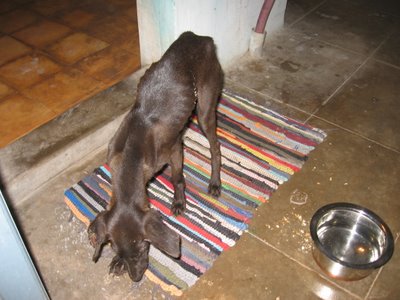
India has another sort of problem all together. For one they use paper ballots with pictures for the different parties and candidates. This results in several problems which are equally difficult to solve. The Indian press has been reporting on these problems and the government's efforts to solve them. One significant problem are armed gangs coming with fake ballots to stuff the ballot boxes. This has been solved with each of the voting centers being heavily guarded with armed police. So what if it feels like martial law when you go to vote. All those men with guns are there to protect democracy...
Another problem involves tampering with votes after they have been cast. For that they put giant padlocks on the metal boxes in which the votes are placed.
The third and perhaps most serious problem you might think would be individuals who attempt to vote more than once, or at more than one voting station. Since many people here don't carry government identification (there are no ID cards like drivers licenses that people carry regularly) instead the resort to a semi-permanent form of body modification. Like a club in New York, or a theater where they stamp your hand, once you have cast your one and only vote, they put a plus sign in ink on your finger and fingernail. Since there are multiple elections, for district representatives, ministers, etc., they reserve different fingers for different elections. In this way they mark you as a citizen, as one who has legally and rightfully participated in the democratic process.
In some ways it seems silly. In America we have computers for that, and you can only vote at your registered center where you are listed on a roster. You have to present proof of identity, but in the end they don't mark you in any way. And yet marking seems like a good idea. That way you can see who cares and who doesn't. On election day if you run into your friends, and you don't see black ink on their fingernail you can chastise them, and tell them to go participate in their democracy. That's what Democracy is supposed to be for. For that matter maybe it should be a tattoo. A small one, to be sure. But still, a small unique mark for each year that you vote. How brilliant would that be?
Video of the congressional testimony on vote machine hacking.
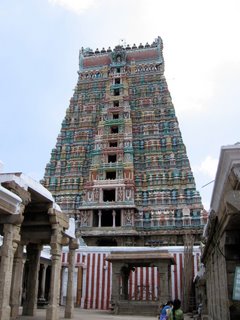

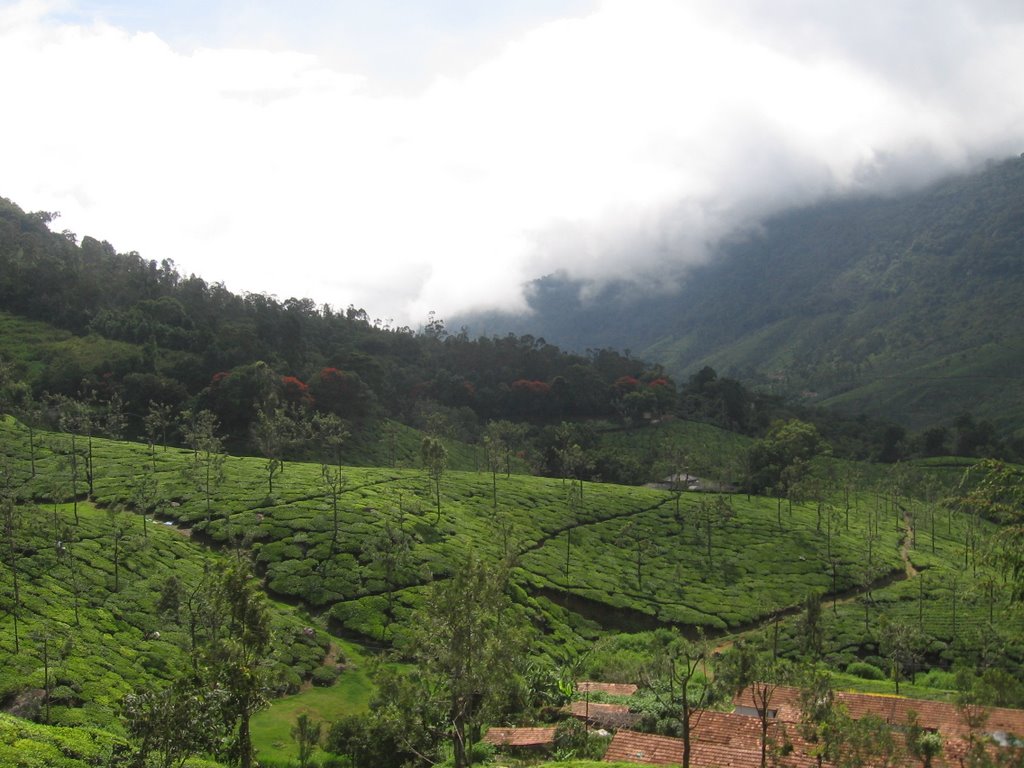

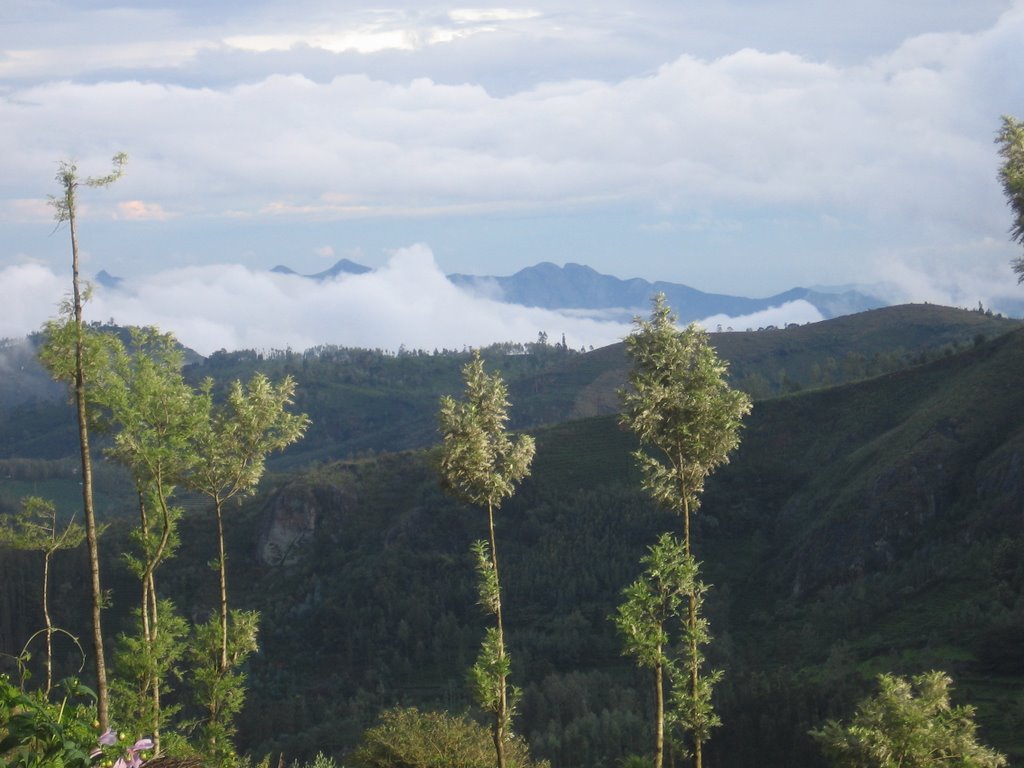 The view from their front door. Clouds and mountains, clouds like mountains.
The view from their front door. Clouds and mountains, clouds like mountains.I also seem to be playing a small role in the politics of the village, since I have been befriended by a woman who is running for village president (what used to be called 'headman'). Her husband who is now dead was the headman many years back, and now she also has the desire to run for office. I was with her before the procession started, as we walked around the village, she greeted many people and introduced them to me. Whether she thinks her friendship with a foreigner will help her in any way, I can't really say. Whether it could actually help her get votes, I don't know. But there are seven people running for the position, so who's to say. 
In India, where I consume almost entirely local products, never drive a vehicle, walk or take the bus almost everywhere, etc. I still consume more than my share of the planet per population. In America, according to my normal American consumer habits it tells me that if everyone in the world lived like me, we would need 4.5 earths to support us all.
Check it out: Earthday.org Footprint Quiz
The travel was uneventful save for the barrage of questions I usually get when people realize I speak some Tamil: Where is your native place? Why have you come to India? Why have you come here specifically? What do you do? What do you study (i.e. what degree)? What subject do you study? How old are you? Are you married? Do you have children? Do you have siblings? Are they married? Do they have children? What do your parents do? Will you get married? When? Do you have a groom already picked out? And sometimes questions like: Why do you have three piercings in one ear and only one in the other? Do you wear Indian clothes in America? Do you wear Sarees? Where do your parents live in the US? Is it a joint family? etc. etc. These questions I answered on the bus to several people on the way to the village and several times to different people in the village. Luckily, once I've told a few people, and they are around, whenever someone else comes by and starts asking the same questions, whoever I've already spoken with begins answering for me. What is especially fascinating is that everyone always asks the same set of questions. Sometimes they only ask the first three or four or five, but the order is almost always the same.
I was also questioned on the bus, as to whether I knew the address where I was going. And I didn't but I knew the name of the village, and the name of a man to talk to when I got there. I hoped that was enough.
Sure enough, I got off of the bus and asked for Mr. Somu and was directed towards a house. It turns out it wasn't Mr. Somu's house, but the house that Dr. Rajan had arranged for me to stay in for the night. They provided me with a bed and a meal, and were very hospitable and nice. Of course they too asked all the same questions, but I didn't mind. Theirs was a joint family, one grandmother, two sons, two daughters-in-law, and 2 grandsons, one for each couple. And they all lived under one roof. Anyway, they fed me a lovely dinner of rice, two kinds of vegetables, sambar, rasam and yogurt. It was delicious. Despite the fact that they had no running water, (a cistern over the kitchen sink and gravity provided it instead) they had a Sony Wega Trinitron TV, cable and a DVD player. So we watched a Tamil movie in the evening while the two two-year old boys played with their toy cars.
In the morning Mr. Somu came and got me and we went to check out the site.
There wasn't alot to see, especially in the habitation area. A mound was not especially apparent, although the scatter of pottery and the fine clear crystal debitage of bead making was very abundant. The trenches had all been filled in, and were not marked anywhere. And the whole thing was under cultivation. There was a lot more to see with the megaliths in the burial part of the site, although that too had been plowed at some point in the past. One large excavated megalith was left open, and I'm pictured below standing down inside it. A few others were apparent on the surface. Also, menhirs, or standing stones were still there and quite obvious. If there were really over 100 megaliths there when Rajan and the archaeologists studied the site nearly 20 years ago, many of them must be gone now, or are no longer visible on the surface.
In any case, it was immensely useful to get a first hand view of the site, rather than simply read about it or look at black and white pictures in a book. As you can see from below, the pictures are nice, but you still don't really get a sense of the whole thing. Of course it's spread out over 50 acres, or so Mr. Somu said.
Luckily I didn't fall in any more septic tanks... (there were several possible candidates, but I was adept at avoiding them.)
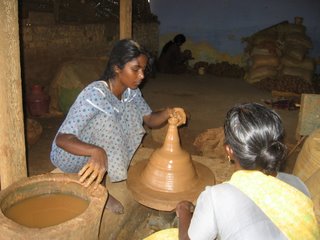
A young girl making small oil lamps for use in temples and home altars for worshipping the various Hindu deities.

Large piles of pottery, finished and ready to ship.
The villagers protested, but the Father had already laid the foundation, and refused to change his plans. The peasants took their case to court, and tried to prevent the building of the church. Though the Father's lawyer advised him to lie in order to win the case, the honest father refused. He had faith in the lord.
Then the judge had a dream, in it the church was being built by 153 angels. (He counted them all. How he could tell them apart I don't know. I always have trouble telling one angel apart from another.) In any case, the Judge found in favor of the father, and convinced the villagers to give up their land. The church was built. In it he installed sculptures of many saints, as well as the 153 angels. Whether they each sat for portraits individually, I don't know.
It was indeed quite beautiful. The stained glass and statues were imported from france although they decided pews were unnecessary as the villagers were used to sitting on the floor.